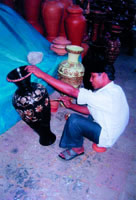Bangladesh
Theme / Exhibition
The people of this country, forged by great rivers fed by snowmelt from the high peaks of the Himalayas, lead lives closely intertwined with nature. Not only do they live on the bounty of nature but they have often had to do battle with nature as it periodically unleashes tidal waves, cyclones and floods.
After many generations of physical and intellectual labor, Bangladesh's tiny landmass of little more than 140,000 square km now supports some 140 million people.
The pavilion presents the way these people live, their civilization and history of Bangladesh through exhibits and audiovisual presentations.
Agriculture lies at the center of economic activities in Bangladesh, and its exports are largely comprised of cash crops like tea and jute. Considering this, many of the things exhibited are agricultural and marine products, but there are replicas of archaeological and ecological tourist sites.
One exhibition highlight is the rickshaw that Dhaka is famed for. These bicycle-taxis are getting a second look these days as cities across the world seek out emission-free, eco-friendly means of transportation. In that sense, it could be said that this foot-powered mode of transport, long in use by the masses, has become cutting-edge.
Through such exhibitions, visitors to the pavilion will likely come away with a deeper understanding of how Third World countries like Bangladesh are trying to rise out of the poverty trap and catch up with the brave new world of eco-sensitive industrial and infrastructural development.



Food / Drink
A restaurant serves ethnic curry, barbeque, kebab, samosa and nan along with juice and ice cream.
Goods
Items available for sale are jute items, leather goods, handicrafts, ceramics, brass items, pottery and semi-precious stones.



